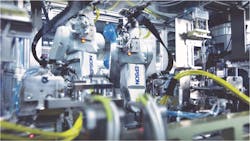Robotic Basics Q&A: Getting Started in Automation
From assembly and pick-and-place to material handling and packaging, the number of robots working in manufacturing and assembly plants continues to grow—a big part of the new wave of factory automation circling the globe. They can handle the simplest and the most complicated tasks while bringing a laundry list of benefits to the table. Taking the plunge into robotics, however, can be confusing and daunting. With so many factors to consider, managers and engineers ask themselves “Where do we start?”
To get some good advice on getting started on the road to robotic automation, Machine Design talked with Rick Brookshire, a group product manager at industrial robot manufacturer Epson.
MD: Why should an average manufacturing company bring automation into their plants with robotics?
Rick Brookshire: Robots are not a panacea, but they can help in critical areas. To get an idea of where and how to use them, consider these five critical considerations:
Cost: Does the company need to lower its current cost per unit?
Volume: Is there a need to increase production volumes but no resources to do so?
Quality: Is the company delivering perfect products, or are there issues with quality and defects?
Precision: Are the parts you assemble too small or precision requirements too tight for humans to handle?
Safety and Repetitive Motion: Are the materials or processes used in the factory unsafe for humans to work with, or are repetitive motions harming employees?
Understanding your primary reasons for automating will help you focus on the right areas as you begin automation projects.
MD: Say you have narrowed down why or what you want to automate. What’s the next step?
RB: The next step, and it is important, is to analyze your current process. By doing so, you’ll be able to decide which steps in the process are most critical and might benefit from automation.
How do you do things today? Think about your current process for building products. Is it documented? Can you explain it clearly to someone not familiar with your process? Begin thinking about how you would document or explain your current process to automation experts, so they clearly understand and can offer ideas on how to automate.
Consider questions such as:
- Where do the components come from? (feeding)
- What are the assembly steps?
- What sort of jigs or special tooling are required for the current process?
There are product and design processes that should be considered when transitioning from a manual to automated operations. DFA (Design for Assembly) offers one way to analyze components and minimize costs by improving the assembly process and reducing the number of parts used. DFA also helps determine if you need to change parts or steps in your process when switching from manual assembly to automation.
Understanding and being able to explain your current process is a critical step, as it can be used to identify strong and weak points that can be improved using automation.
MD: Are there common problem areas that should be looked at first for automation?
RB: Problem areas can range from bottlenecks in your process to poor-quality parts. Think about problem areas associated with your current process. Consider the following:
- What is slowing down the automation process?
- Are there easily identifiable bottlenecks?
- Are you consistently experiencing failures that require rework?
- Is the final product meeting quality standards?
- Are you making enough product in a timely fashion?
- Are costs to manufacture too expensive using your process?
Let’s use an example to help clarify identifying problem areas.
Assume a team of assemblers builds a product with a molded plastic body and two metal inner parts. The process has an assembler pulling a plastic body shell out of a bag and placing it in a fixture. Next, he grabs two metal parts from two separate bins and slides them into slots on the plastic body. Then he fastens the metal parts with an electric screwdriver.
Sounds simple, right? On the surface it may be, but the potential for quality issues is huge, given the number of things that could go wrong. Let’s list just a few areas of concern:
A Variety of Plastic Body Shells: If there are several types, how do you separate them and make sure the correct one is used for each process?
Deviation in Part Tolerances: Many times, we tend to believe the process doesn’t work due to human error, but have you considered the parts may be out of tolerance?
Proper Part Insertion (Right-Side-Up Issue): Sometimes parts can be inserted two or more different ways, but only one is correct. How do you ensure parts always get inserted right-side-up?
Screw Driving Issues: How do you ensure all the screws are fastened properly (i.e., not stripped or missed)?
Each of these items could be related to quality, and they could also be related to cycle times. Which steps in the process take the most time? Which are the most prone for rework or readjustment and therefore take more time? Which might be too repetitive and therefore cause pain or injury to workers?
These could all be considered problem areas in your process and are just a few items from a simple example. Knowing the problem areas will help create a solid approach to automation. Sharing this information will let a robot expert, Systems Integrator (SI), or other experienced outside party quickly and easily find the most effective approach.
MD: What are the important requirements of new robotics systems?
RB: To automate a process, managers need to identify requirements central to their business and prioritize them based on importance. There are three requirements central to manufacturers: speed, precision, and payload. These requirements must be prioritized because, for most applications, you must compromise between them. This means you must decide which is most critical of the three.
For example, there are applications where customers request the fastest speed possible because their PPM (parts per minute) cycle rate is critical. In these cases, focus on reducing overall cycle times by reducing tooling weight or shortening motion paths. Other times, precision is critical. In those cases, reduce speeds and payloads (again, tooling) to get the best precision possible. The tradeoffs will vary from application to application. The important takeaway is to know your specific application’s requirements.
Some key requirements you need to identify for every application are:
Precision: Many managers simply aren’t sure of their precision requirements. Although some robots have repeatability down to 5 microns, most applications in the small assembly arena range from 25 to 200 microns in terms of precision. Look at the components being put together and the tolerances required for the parts to be placed reliably. Qualified robot vendors or SIs can help define placement tolerances (or precision requirements) for any application. This is an area where a target is required, because it will affect all aspects of the overall automation effort.
Payload: A common misconception is that the payload is only the weight of the part being moved. But it’s the total weight on the end of the arm, which also includes tooling (gripper, suction cup). Usually, for smaller parts, the tooling weighs much more than the parts, so be sure to consider both the maximum part weight and the tooling weight when defining the maximum payload. Also, keep in mind that although robots are rated with maximum payload specifications, it is sometimes a good idea to move up to a larger robot when you get close to the maximum. This is an area where the robot vendor can guide you in selecting the proper robot.
Cycle Time: How many parts do you need to turn out each week? Knowing this lets you use a simple calculation to determine cycle time or PPM required for the robot. With a cycle time in hand, the robot vendor can help choose the best robot(s) for your factory and determine if it will take several robots. There are many ways to increase throughput including multi-headed tooling and motion improvement.
Reach: Characteristics such as part size and the distance required to move them determine reach. Robot vendors can help define reach requirements. However, they will need to understand the total process and all parts and components required in the workcell. By understanding the layout, reach can be determined and a robot with the appropriate reach capacity selected.
MD: Once the process is defined and requirements identified, what automation components should be considered??
RB: You’re not up to that stage yet. Even after the process is defined and requirements identified, there are still several factors to consider at this phase. These include:
Parts Presentation: How will the parts get to the robot? (Bowl feeder, flexible feeder, or some type of conveyor?) Also, are there any fixtures needed during assembly? Many robots require special fixtures that hold parts place and manipulate them (flip or rotate them) during assembly.
Vision: If parts cannot be fed within proper tolerances, machine vision may be needed and added to the robot for precise pickup or placement. Machine vision may also be required for inspecting components or finished assemblies.
End-of-Arm Tooling (EOAT): This includes all the devices attached to the end of a robot’s arm to allow it to grasp and work with parts. From pneumatic devices to mechanical grippers, end-of-arm tooling is vital to every robot. Although standard grippers can be used for some applications, it often takes custom tools for higher speeds or more precisions. If this is the case, use an experienced tool designer to define and build the EOAT.
Factory Standards: Do you have a standard fieldbus communications platform within your factory? Do you use Ethernet/IP, ProfiNet, DeviceNet, or another communication protocol? Are there other standards you need to consider and let your SI know about?
Base: Every robot needs a base. The more mass that is moving (i.e., heavier robots or payloads), the more rigid the base needs to be to handle fast motions and high precision. Lightweight or less-rigid bases will move when the robot moves. This slows down cycle times and can require the robot stabilizes before placing components due to vibrations. The base is the core for the robot, so select or build an appropriate one that takes into account cycle times and precision requirements.
MD: So, who should be called upon to build the system?
RB: The answer to that question may be within your company or you may need to look outside. Chances are, you don’t have every needed tool available in-house, but you may have some. Is there an in-house engineering team? You will typically need a controls engineer, electrical engineer, mechanical engineer, and software engineer, or people well-versed in each of these disciplines.
If you don’t have the necessary resources in-house, contact an SI. They specialize in designing robot workcells that build all types of products. They have experience with best-in class robots and components needed to build your automation equipment. SIs work with manufacturers to pull together every component of your robotic army—essentially a one-stop shop.
Whether you decide to design and build your robot in-house or with an SI, remember that robot vendors also have tremendous automation experience and can help with component decisions, layouts for maximum throughput, improving performance, tooling ideas, and other areas of automation projects. Be sure to ask for help at the beginning of the process, as most robot vendors will be happy to assist, saving time and money in the process by getting involved early.
Rick Brookshire is group product manager at Epson. If you have any questions about robotics and automation, call Epson at (562) 290-5997, or visit the company's website.



